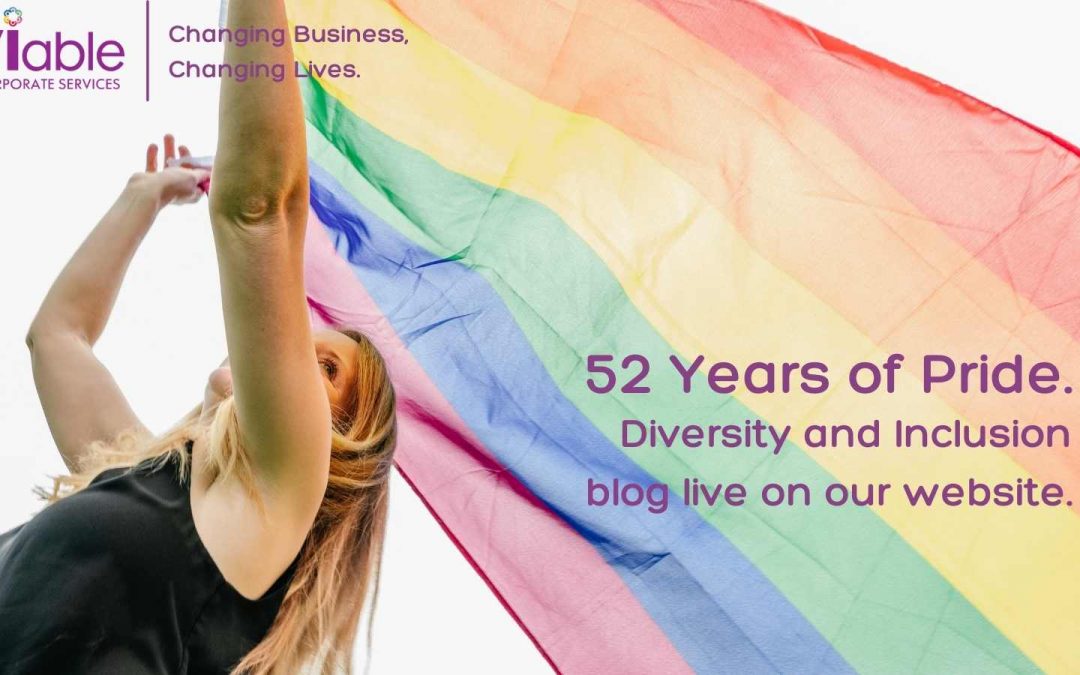Yesterday, the 28th June, marks 52 years since the protests at Stonewall, and the rise of Diversity and Inclusion. 52 years ago, LGBT individuals inNew York rioted following a police raid on the Stonewall Inn.
In November 1969, the first proposal for Pride month and Pride day came from New York at the Eastern Regional Conference of Homophile Organizations (ERCHO):
“That the Annual Reminder, in order to be more relevant, reach a greater number of people, and encompass the ideas and ideals of the larger struggle in which we are engaged—that of our fundamental human rights—be moved both in time and location. We propose that a demonstration be held annually on the last Saturday in June in New York City to commemorate the 1969 spontaneous demonstrations on Christopher Street and this demonstration be called CHRISTOPHER STREET LIBERATION DAY. No dress or age regulations shall be made for this demonstration. We also propose that we contact Homophile organizations throughout the country and suggest that they hold parallel demonstrations on that day. We propose a nationwide show of support.”
Eastern Regional Conference of Homophile Organisations (ERCHO, June 1969)
52 years later, and that movement sparked change for the lives of the LGBTQIA+ community all across the world, and arguably drove the movement toward acceptance, diversity and inclusion in contemporary society.
In workplaces in modern society, diversity and inclusion are now common and expected policy. Moreover, prospective employees find diverse and inclusive cultures more appealing, and so employers that drive diversity in the workplace often attract better talent.
What are diversity and inclusion, however, and how can you integrate them in to your culture in an understanding and accepting way?
This Pride Month 2021, we’re reflecting on Diversity and Inclusion, what the terms mean, and what ways you can help build a truly diverse and inclusive workforce.

Defining diversity and inclusion
Often, diversity and inclusion go hand-in-hand, but in fact are very different practices. In implementing HR and people management strategies, employers must therefore consider both as separate approaches.
Diversity and Inclusion are defined as:
“recognising difference. It’s acknowledging the benefit of having a range of perspectives in decision-making and the workforce being representative of the organisation’s customers.” – CIPD
Definition of Diversity – CIPD
Whilst inclusion can be defined as:
Definition of Inclusion – CIPD
“Where people’s differences are valued and used to enable everyone to thrive at work. An inclusive working environment is one in which everyone feels that they belong without having to conform, that their contribution matters and they are able to perform to their full potential, no matter their background, identity or circumstances. An inclusive workplace has fair policies and practices in place and enables a diverse range of people to work together effectively”
Both definitions outline the idea of “differences”. Differences can be both visible and non-visible, and may include personal characteristics such as background, culture, personality, work-style, accent and language.
As an employer, it is important to recognise a “one-size fits all” approach to people management is ineffective. Different groups of people have different beliefs, thoughts and needs. Therefore, identifying those needs, and adopting a flexible but consistent approach across all stakeholders in the organisation is key.
Benefits of diversity and inclusion
Diversity and inclusion has a vast range of benefits for business.
Firstly, the policy ensures that you are acting within the parameters of the Equality Act of 2010. All individuals in the UK have the right to be free of any indirect or direct discrimination, and to be treated fairly and equally. You can read more about the equality act, including a code of practice at this link.
Secondly, diversity and inclusion attracts talented employees. CIPD highlight that employers are becoming more actively aware that in order to attract and retain the skills they need, they must drive diverse and inclusive workplace policies. Moreover, McKinsey & Company surveyed 366 companies, and found that gender diverse organisations where 15% more likely to secure higher margins, whilst ethnically diverse organisations were 35% more likely.
Moreover, in terms of corporate reputation and perception, diversity and inclusion can drive a positive consumer perception. Consider the importance of corporate social responsibility (CSR), especially in the wake of an aging millennial consumer and employee, who are passionate about social action and inclusive organisations. If employers want to attract and retain millennial talent who offer fresh and innovative ideas, they must look inward at their approach to culture.
Discrimination and protected characteristics
Whilst they are benefits, with everything in business, risks exist. Where an employer fails to implement effective diversity and inclusion policies, discrimination may come to the fore. The fallout from discriminatory behaviour can be detrimental to business success, and when consider people management approaches, it is essential to ensure you are informed about protected characteristics.
In the UK, certain characteristics are protected by legislation. Under these characteristic groups, any unfair or ill-treatment on basis of the individual having certain characteristics can be classified as discrimination.
The protect characteristics are:
- Age
- Disability
- Gender reassignment
- Marriage and civil partnership
- Pregnancy and maternity
- Race
- Religion and belief
- Sex and sexual orientation
Discrimination can have negative impacts both on your business, and on your people’s performance and health.
Therefore, not fostering a diverse and inclusive culture may lead to high employee turnover, affect your recruitment, and also may lead to legal disputes in the case of direct discrimination. Moreover, not having policy and guidelines may lead to precarious situations that could impact corporate reputation, and be detrimental to firm success, authenticity and consumer trust.

How do I start implementing diversity and inclusion?
Implementing diversity and inclusion effectively requires a systemic organisational change. As with any period of change, cultural adjustment is required, and significant barriers and challenges can exist in changing individual behaviour.
Despite the challenge, implementing and changing is entirely possible, although organisations will want to strategize and plan their approach. Moreover, upper management, middle management and staff must understand that this is a continuous process, rather than a one-off training session. Fostering a diverse and inclusive workplace means staff must be open-minded, aware and accountable for all of their behaviour, and must work collectively to welcome, accept and promote the inclusion of a wide diversity of individuals.
We propose a strategic approach below, considering the following stages of your people management processes, and ensuring diversity and inclusion are actively considered, measured and monitored at each stage.
Cultural change
A cultural shift must first be implied in the organisation. From the top level down, staff and management must be informed on the implementation and requirement to encourage a diverse and inclusive workforce.
Moreover, employees must then work collectively, changing behaviour and holding each other accountable to uphold an inclusive workforce.
Management should adopt Soft HR Management practice where possible, creating an open-minded and approachable internal culture where staff feel comfortable to discuss insecurities or discomforts due to their differences.
Fostering a culture where teams can openly discuss and express themselves in turn will enable minority characteristic groups in the firm culture to feel included and safe, driving workplace happiness and motivation.
Policy and procedure
Whilst not legally binding, a workplace diversity and inclusion policy can provide parameters for staff to help reinforce expectations. Upper management should work with top level teams to formulate a policy that suits the organisations’ needs at that moment in time.
Thereafter, the policy should be read by all employees, and effectively implemented by management teams to ensure all staff are informed around the expectations in relation to diversity and inclusion.
Furthermore, a policy can help support a cultural shift. The policy will ensure that all staff understand diversity and inclusion the same way, and understand their employers’ expectation of them. The policy can then be used going forward for inductions, ensuring new staff start their career with the organisation in the right way.
Employee engagement
Ensuring employees are part of the cultural change process can be a great way to drive engagement, both with the change and between management and staff. By giving staff a say in what they would expect in terms of diversity and inclusion, and surveying their perspectives on the case, you can ensure their views are heard.
Not only does this make your employee feel valued, but it allows them to be a part of the strategic direction of the organisation. Staff want to be heard, listened to and make an impact, and employee engagement through surveys, focus groups and feedback can be a great way to keep employees engaged, and foster ownership over cultural changes.
Training and understanding
With policies in place, staff surveyed and focus groups conducted, it’s time to train. Staff should be taken in to group training sessions, ideally in diverse groups from different protected characteristics. These sessions should be engaging, innovative and thought provoking, opening up staff empathetic thinking and sympathetic thinking. This type of thinking then drives staff to be more inclusive of one another.
When staff start to understand one another, our lives and situations, it creates a conversation and open minded attitude.
All staff should be trained on diversity and inclusion, the employers’ expectation, and then this training should be monitored and re-implemented where issues start to arise.
Recruitment and induction
When recruiting, HR teams should look both internally at team composition and at the candidates applying. HR Management should question where their team currently lacks certain characteristic groups, and perhaps their diversity is limited.
Whilst not being discriminatory in recruitment processes, HR must ensure they strike a balance between impartial decision making in recruitment, but also maintaining effective balances in their workplace diversity.
Thereafter, once a successful candidate has been identified that suits the diversity composition, that employee should be inducted through the organisations’ policy on diversity and inclusion.
Continuous review and measuring
With every employee touchpoint reviewed, each stakeholder in the organisation must make a constant and continuous effort to review their own actions and behaviour. Moreover, HR must measure staff diversity, and actively survey staff through wellbeing surveys to ensure inclusivity is being upheld.
Where performance does not meet organisation key performance indicators (KPIs) or goals around diversity and inclusion, there must be internal intervention to review the approach, adjust and implement training or change policy where required.
These are just some situations to review in approaching the implementation of a diversity and inclusion strategy. As with all HR challenges however, a lot is dependent upon organisational structure, size and internal organisational behaviour.
What is key to implementing effective diversity and inclusion practices is consistency. Organisational stakeholders must hold each other accountable, protect and uphold each other’s rights and respect, and ensure that all are made to feel included.
Need help with constructing a diversity and inclusion policy? Our HR experts provide detailed policies for a wide range of organisational scenarios. Whether you need a policy reviewed or a full staff handbook, we are on hand to support your HR Challenges. Learn more our HR services by clicking here. We have also created a full guide to diversity and inclusion, which you can download for free on our resources page.
Alternatively, you can fill in the form below, and we’ll reach out to you to start a conversation around your policy and culture challenges.



Recent Comments